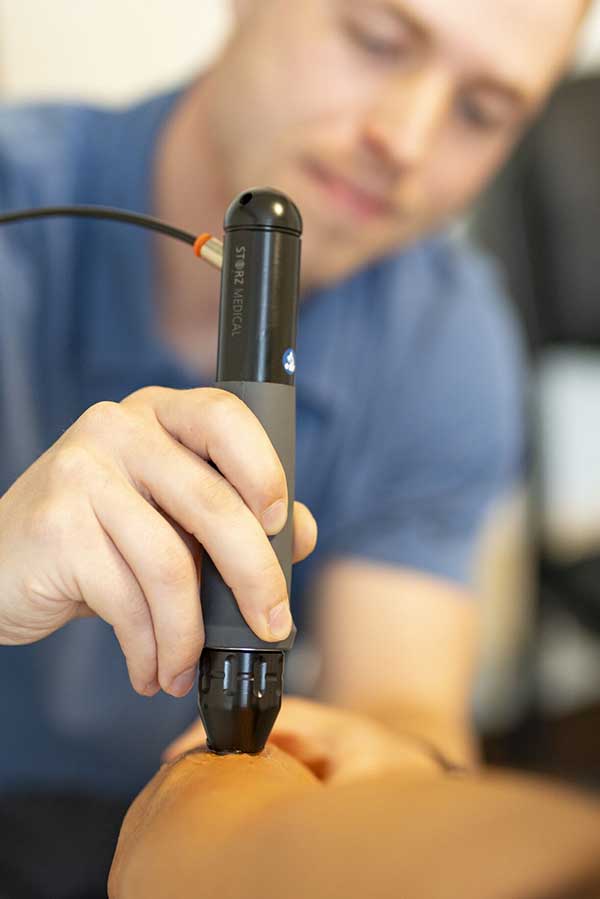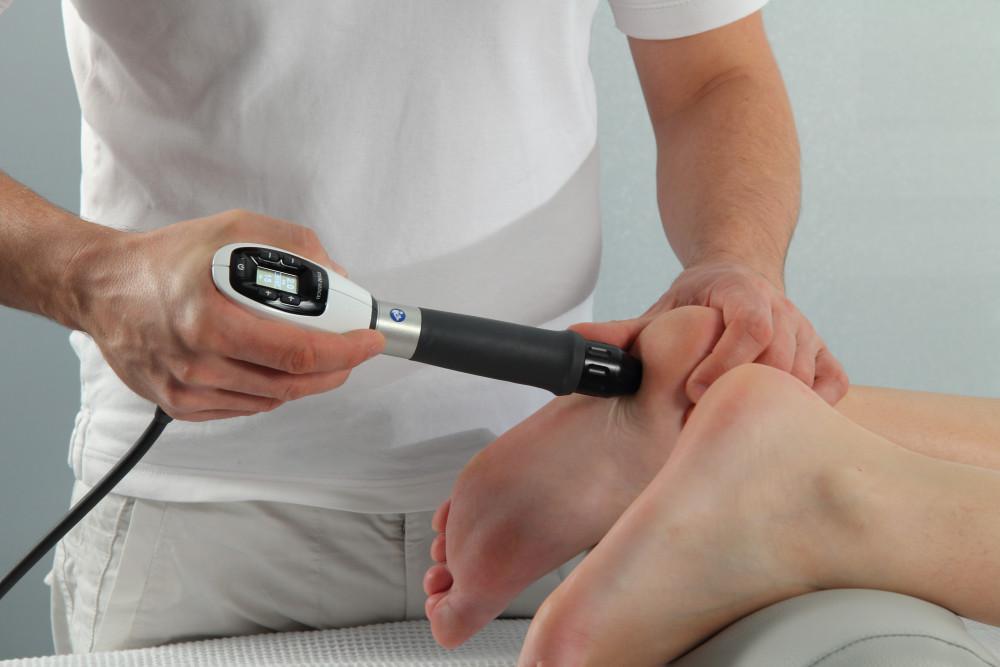
Process of Shockwave Therapy Treatment
Shockwave therapy, or extracorporeal shockwave therapy (ESWT), is an innovative, non-invasive treatment for various types of pain by stimulating the body’s natural healing process.
Shockwave therapy uses specialist devices that deliver acoustic energy to the targeted injured body part through the skin. These shockwaves are mechanical, audible, low-energy waves that increase blood flow to the patient’s injured area.
Shockwave therapy uses two main processes. In the first process, the shockwaves desensitize nerve endings to reduce pain immediately. In the second process, the shockwaves create controlled micro-trauma or microscopic damage to the tissues to facilitate the body’s response and increase blood circulation and metabolism in the affected area.
Shockwave treatment typically takes 5-10 minutes, depending on the condition. It also takes 3-4 therapy sessions, 5-10 days apart. Patients should refrain from physical activity associated with the treatment for at least 48 hours after every treatment session.
Types of Devices Used in Shockwave Treatment
There are four main types of shockwave devices, and they include:
Focused Shockwave Therapy Device
This device delivers high-energy shockwaves to the target area, making it the best option for treating localized conditions such as calcific shoulder tendinitis, planter fasciitis, and tendinitis. It uses focused shockwave technology that concentrates shockwave energy on a specific area deep in the patient’s tissues to maximize therapeutic effects while minimizing damage to surrounding structures.
Radial Shockwave Therapy Device
This device emits shockwaves in a divergent or radial pattern to spread shockwaves across a broader area of the target tissues. This makes it ideal for treating conditions requiring a diffuse treatment approach or larger areas. Some of the conditions that require this type of treatment include myofascial trigger points, chronic pain syndromes, and cellulite reduction.
Electromagnetic Shockwave Therapy Device
This device uses electromagnetic technology to produce shockwaves that precisely control penetration depth and energy delivery. It is often recommended for its adjustable parameters, which allow chiropractors to tailor treatment according to a patient’s needs.
Pneumatic Shockwave Therapy Device
This device generates shockwaves using compressed air, offering a reliable, cost-effective therapy option. It’s known for its durability and simplicity, making it ideal for clinical settings where efficiency is required. It’s widely used in sports medicine, physical therapy, and rehabilitation centers that manage soft tissues.

Conditions Treated with Shockwave Therapy
Shockwave therapy is used to treat various musculoskeletal conditions in Whitefish Chiropractic. Examples of the specific conditions that we treat using this therapeutic approach include the following:
- Plantar fasciitis
- Tennis elbow
- Knee pain or patella tendinopathy
- Hamstring injuries
- Hip pain such as lateral hip pain and rectus femoris
- Shoulder pain like rotator cuff injuries
The National Institute for Health and Care Excellence (NICE) and other related organizations support using shockwave therapy for pain treatment. Plenty of double-blind, controlled, and randomized research supports it. They indicate up to 91% improvement in pain management and an 84% success rate for various conditions.
When it comes to improvement for specific conditions, these researches indicate:
- 84% improvement in plantar fasciitis
- 91% on shoulder calcific tendonitis
- 77% for tennis elbow
- 76% for Achilles tendinopathy
- 95% for myofascial trigger point
- 85% for hamstring injuries
- 76% for patellar tendonitis.
Role of a Chiropractor in Shockwave Therapy
Shockwave therapy is typically used in chiropractic services when other care techniques are unsuccessful in treating pain before deciding on more invasive or surgical options. A chiropractor is a licensed healthcare professionals who rely on the body’s natural healing process in their treatment. Therefore, since this is a non-invasive approach to healing pain, it suits their practice.
Other benefits of using shockwave therapy in chiropractic include:
- It’s a suitable approach to lowering Substance P
- It improves the formation of new blood vessels
- Releases trigger points in the limbs, back, neck, shoulders, and other areas causing pain
- Suitable for reversal of chronic pain
- Increases recovery time
Experience Lasting Relief with Whitefish Chiropractic’s Shockwave Therapy
If you’re suffering from chronic pain, shockwave offers a reliable, non-invasive, and cost-effective treatment. Regardless of the pain you’re experiencing, this treatment procedure offers a unique approach to your treatment.
At Whitefish Chiropractic, we offer quality chiropractic care to patients in Whitefish, Columbia Falls, Kalispell, and their surroundings, including shockwave therapy. With over two decades of clinical experience, Dr. Ryan Wigness , Dr. Mike Sybrant, and Dr.Connor Tobisch are ready to lead you into a more active and healthier life with their services. Contact us today to schedule your appointment.
Testimonials
We encourage you to read some of our patient testimonials to understand better who we are and how we work.
“After having bad Chiropractor experience, I finally found a doctor that knows what he’s doing and is caring & compassionate! Dr. Wigness was wonderful at finding my problems and went right to work on those areas. He gave me info so that I can continue to work on these areas at home. I’m looking forward to my next appointment & THANKFUL I’ve FOUND a Chiropractor I can trust!” – Thalia D. // Kalispell, MT
“I will be 70 this month and because of you I still hunt,fish, spit wood and all my activities. Many thanks!” – Sheila G. // Kalispell MT
“Dr. Wigness is great. Has a way with kids. My children are very comfortable with him and his adjustments.” – Jackson D. // Whitefish, MT
Other conditions we treat include:
- Golfer’s elbow
- Soft-tissue adhesions
- Plantar fasciitis
- Pinched nerves
- Sprains and strains
- Arthritis
- Arm pain
- Hand pain
- Foot pain
- Joint pain
- Disc injuries
- Degenerative disc disease
- Mobility problems
- Balance problems
- Rotator cuff syndrome
- Shin splints
- Overuse injuries
- Degenerative joint disease
- Muscle spasms
- Post-surgical back pain
- Disc bulge
- Frozen shoulder
- Impingement syndrome
- Torticollis
- Spinal stenosis
- Failed back surgery
- Adhesive capsulitis
- Iliotibial band syndrome
- Radiculopathy
- Regional pain syndrome
- Lateral / medial epicondylitis
- Piriformis syndrome
- Temporomandibular disorder
- And more
